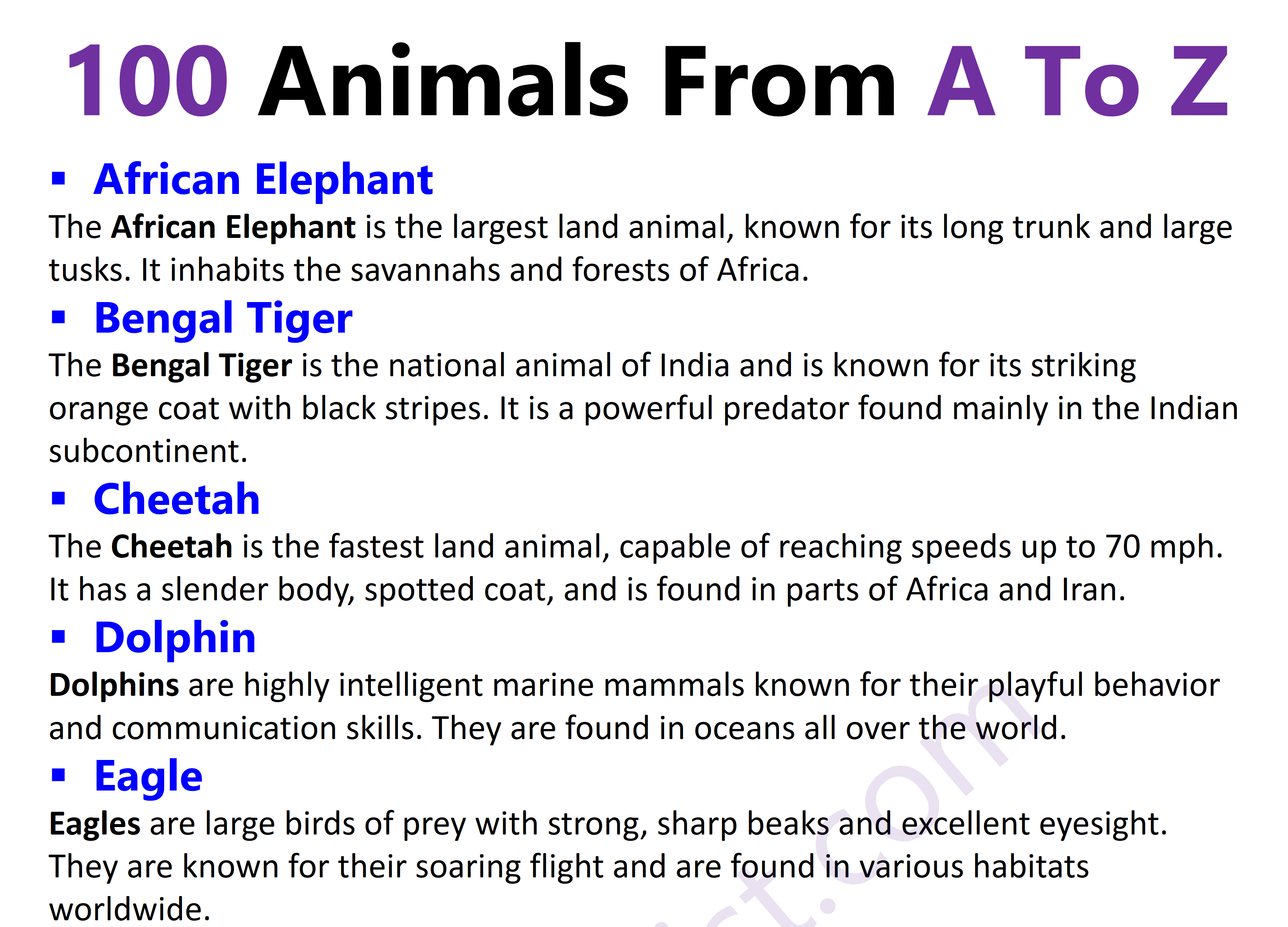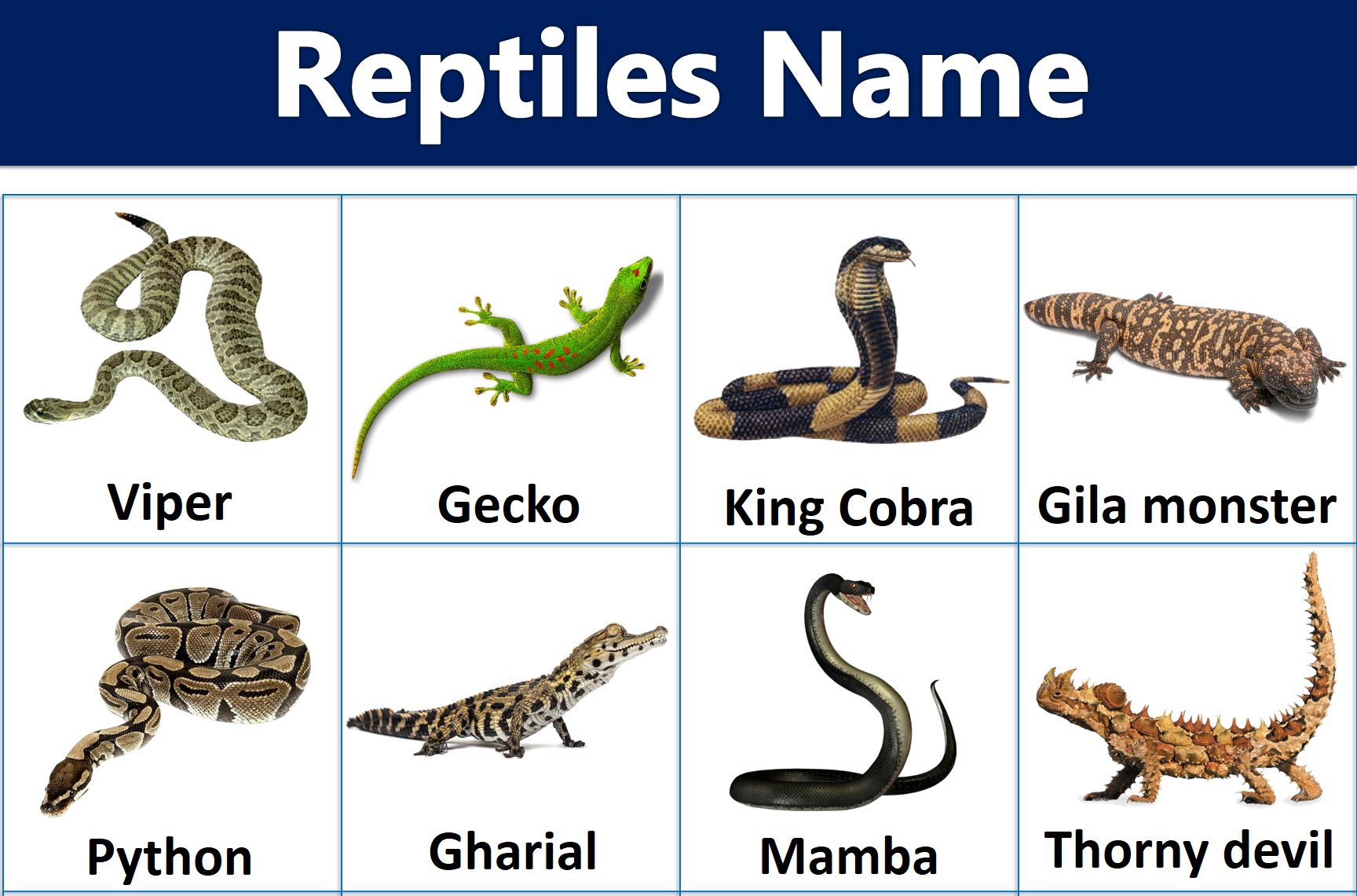100 Fascinating Animals names from A to Z! Explore the incredible diversity of the animal kingdom with our comprehensive list of 100 fascinating animals from A to Z. This blog post takes you on an exciting journey through various habitats and continents, introducing you to a wide range of creatures, from the iconic to the lesser-known.
Discover the majestic lion, known as the king of the savannah, and learn about its hunting strategies and social structure. Immerse yourself in the colorful world of coral reefs as you encounter the mesmerizing clownfish and the graceful sea turtle. Delve into the rainforests and meet the elusive jaguar, with its stunning coat and stealthy hunting skills.
From the smallest insects to the largest mammals, each animal comes with a short description that highlights its distinctive features and behaviors. Learn about the intelligence of dolphins, the intricate web-spinning abilities of spiders, and the mesmerizing songs of nightingales. Gain insights into the diverse adaptations that enable animals to thrive in their respective environments, such as the camouflaging abilities of chameleons and the powerful flight of falcons.
Not only will you encounter familiar favorites like elephants, tigers, and pandas, but you’ll also discover unique and lesser-known species. Marvel at the quetzal’s vibrant plumage, learn about the remarkable nesting habits of penguins and delve into the mysterious world of nocturnal creatures like the bat and the owl.
Whether you’re an animal enthusiast, a nature lover, or simply curious about the incredible creatures that inhabit our planet, this article is a captivating resource. Explore the animal kingdom like never before as you expand your knowledge and appreciation for the remarkable diversity of life on Earth.
Join us on this virtual safari and be inspired by the wonders of the animal world as we celebrate the beauty, adaptability, and awe-inspiring qualities of these 100 extraordinary animals.
100 List of Animals from A to Z
- African Elephant: The African Elephant is the largest land animal, known for its long trunk and large tusks. It inhabits the savannahs and forests of Africa.
- Bengal Tiger: The Bengal Tiger is the national animal of India and is known for its striking orange coat with black stripes. It is a powerful predator found mainly in the Indian subcontinent.
- Cheetah: The Cheetah is the fastest land animal, capable of reaching speeds up to 70 mph. It has a slender body, and spotted coat, and is found in parts of Africa and Iran.
- Dolphin: Dolphins are highly intelligent marine mammals known for their playful behavior and communication skills. They are found in oceans all over the world.
- Eagle: Eagles are large birds of prey with strong, sharp beaks and excellent eyesight. They are known for their soaring flight and are found in various habitats worldwide.
- Flamingo: Flamingos are tall, wading birds with long, thin legs and distinctive pink plumage. They are known for their communal nesting and are found in parts of Africa, Asia, the Americas, and Europe.
- Giraffe: The Giraffe is the tallest land animal, with a long neck and distinctive patchy coat. They inhabit the savannahs of Africa and use their long necks to reach leaves from tall trees.
- Hippopotamus: Hippos are large, semi-aquatic mammals known for their barrel-shaped bodies and massive jaws. They are found in sub-Saharan Africa and spend most of their time in water.
- Iguana: Iguanas are lizards with long tails and rough, scaly skin. They are found in tropical regions and are known for their ability to change color for camouflage.
- Jaguar: Jaguars are large cats native to the Americas and are known for their powerful build and distinctive rosette-patterned coat. They are skilled hunters and swimmers.
- Kangaroo: Kangaroos are marsupials found in Australia. They have powerful hind legs and a tail, which they use for hopping. Kangaroos carry their young in a pouch.
- Lion: Lions are majestic big cats known for their iconic manes and powerful roars. They are apex predators and are primarily found in sub-Saharan Africa.
- Monkey: Monkeys are intelligent and highly adaptable primates found in various parts of the world. They have long tails and exhibit a wide range of behaviors.
- Narwhal: Narwhals are medium-sized whales known for their long, spiral tusks. They inhabit Arctic waters and are often referred to as the “unicorns of the sea.”
- Octopus: Octopuses are marine animals with eight arms, each lined with suckers. They are known for their exceptional problem-solving skills and ability to change color and shape.
- Panda: Pandas are large, black-and-white bears native to China. They primarily feed on bamboo and are classified as endangered species.
- Quokka: Quokkas are small marsupials native to Western Australia. They are known for their friendly and curious nature, often approaching humans without fear.
- Rhino: Rhinos are large, herbivorous mammals with thick, protective skin and one or two horns on their snouts. They are found in Africa and Asia and are threatened by poaching.
- Shark: Sharks are cartilaginous fish known for their streamlined bodies and sharp teeth. They are apex predators in the ocean and come in various species.
- Tiger: Tigers are the largest members of the cat family and are renowned for their strength and agility. They have distinctive orange fur with black stripes and are native to Asia.
- Unicorn: Unicorns are mythical creatures often depicted as horse-like animals with a single horn on their forehead. They appear in folklore and are associated with purity and grace.
- Vulture Description: Vultures are scavenging birds with bald heads and sharp beaks. They play a crucial role in ecosystems by feeding on carrion and helping prevent the spread of diseases.
- Whale: Whales are enormous marine mammals that inhabit oceans worldwide. They are known for their size, song-like vocalizations, and annual migrations.
- X-ray Tetra: X-ray Tetras are small, tropical freshwater fish with translucent bodies. They are named for their transparent appearance, which allows their internal organs to be visible.
- Yak: Yaks are large, shaggy-haired bovids found in the Himalayan region. They are adapted to high-altitude environments and are used as pack animals by local communities.
- Zebra: Zebras are equids known for their black-and-white striped coats. They are social animals and are found in grasslands and savannahs in Africa.
- Alligators: Alligators are large reptiles with long, armored bodies and powerful jaws. They are native to the Americas and are primarily found in freshwater habitats.
- Baboon: Baboons are primates known for their distinctive long, dog-like snouts and cheek pouches. They are found in various habitats in Africa and exhibit complex social structures.
- Camel: Camels are large mammals with humps on their backs and adapted to desert environments. They are known for their ability to store water and survive in arid conditions.
- Duck: Ducks are waterfowl birds found in both fresh and saltwater habitats. They have webbed feet and a broad bill, and many species are known for their quacking sound.
- Elephant Seal: Elephant seals are large seals named for their size and long trunk-like noses. They are found in the Southern Hemisphere and are known for their impressive breeding colonies.
- Fox: Foxes are small to medium-sized mammals with bushy tails and a pointed snout. They are known for their cunning behavior and adaptability to various habitats.
- Gorilla: Gorillas are the largest primates and share DNA with humans. They live in the forests of central Africa and are known for their strength and gentle nature.
- Hummingbird: Hummingbirds are tiny birds with vibrant feathers and wings that beat rapidly. They are known for their ability to hover in mid-air and feed on nectar from flowers.
- Ibex: Ibexes are wild goats known for their long, curved horns and nimble climbing abilities. They inhabit mountainous regions in Europe, Asia, and Africa.
- Jellyfish: Jellyfish are gelatinous marine creatures with long, trailing tentacles. They have a unique body structure and are found in oceans worldwide.
- Koala: Koalas are marsupials native to Australia, known for their fluffy appearance and eucalyptus diet. They spend most of their time sleeping or resting in trees.
- Lemur: Lemurs are primates endemic to Madagascar and nearby islands. They have large, reflective eyes and a long, bushy tail. Lemurs come in various species.
- Macaw: Macaws are brightly colored parrots found in the rainforests of Central and South America. They are highly intelligent and known for their vocalizations.
- Nightingale: Nightingales are small, migratory birds known for their beautiful and melodious songs. They are found in Europe, Asia, and Africa.
- Ostrich: Ostriches are flightless birds known for their long necks, long legs, and running speed. They are native to Africa and are the largest living bird species.
- Penguin: Penguins are flightless birds that inhabit the Southern Hemisphere, primarily in Antarctica. They have a streamlined body, wings adapted for swimming, and a unique waddling gait.
- Quail: Quails are small birds known for their plump bodies and distinctive calls. They are found in diverse habitats worldwide and are often hunted for their meat and eggs.
- Rabbit: Rabbits are small mammals known for their long ears, fluffy tails, and rapid reproduction. They are found in various habitats globally and are popular as pets.
- Sloth: Sloths are slow-moving mammals found in the forests of Central and South America. They have long claws and spend most of their time hanging upside down from trees.
- Toucan: Toucans are brightly colored birds with large, colorful bills. They are found in the tropical rainforests of Central and South America and are known for their vibrant plumage.
- Uakari: Uakaris are small primates with red faces and short tails. They inhabit the Amazon rainforest in South America and are known for their distinct appearance.
- Vervet Monkey: Vervet Monkeys are medium-sized primates found in Africa. They have a grayish coat and are known for their distinct alarm calls and social behavior.
- Wolf: Wolves are carnivorous mammals known for their pack behavior and distinctive howling. They are found in various habitats worldwide and play a vital role in ecosystems.
- Xenopus: Xenopus, also known as African Clawed Frogs, are aquatic frogs found in sub-Saharan Africa. They are often used in scientific research and have unique reproductive habits.
- Yak: Yaks are large, shaggy-haired bovids found in the Himalayan region. They are adapted to high-altitude environments and are used as pack animals by local communities.
- Zebra: Zebras are equids known for their black-and-white striped coats. They are social animals and are found in grasslands and savannahs in Africa.
- Antelope: Antelopes are herbivorous mammals known for their agility and graceful movements. They are found in various habitats in Africa, Asia, and parts of the Americas.
- Bat: Bats are the only mammals capable of sustained flight. They have wings formed by elongated fingers and are found in diverse habitats worldwide.
- Chimpanzee: Chimpanzees are highly intelligent primates and are the closest living relatives to humans. They are found in forests across central and West Africa.
- Dingo: Dingoes are wild canines native to Australia. They are medium-sized dogs with a lean build and are known for their adaptation to harsh desert environments.
- Elk: Elks, also known as Wapiti, are large members of the deer family. They have impressive antlers and are found in North America and parts of Asia.
- Falcon: Falcons are birds of prey known for their exceptional hunting abilities and swift flight. They have pointed wings and a hooked beak, and are found worldwide.
- Gecko: Geckos are small lizards known for their ability to climb walls and ceilings due to their specialized toe pads. They are found in warm climates around the world.
- Hermit Crab: Hermit crabs are crustaceans that live in empty shells for protection. They are found in oceans worldwide and exhibit a unique behavior of changing shells as they grow.
- Ibis: Ibises are wading birds with long legs and long, curved bills. They are found in wetland habitats and are known for their distinctive beak shape.
- Jackal: Jackals are medium-sized canids known for their scavenging and hunting abilities. They are found in Africa, Asia, and southeastern Europe.
- Kingfisher: Kingfishers are small to medium-sized birds known for their vibrant plumage and specialized beaks for catching fish. They are found near water bodies worldwide.
- Llama: Llamas are domesticated mammals native to South America. They are known for their woolly coats, and long necks, and are used as pack animals and for their fiber.
- Magpie: Magpies are medium-sized birds with black and white plumage and long tails. They are known for their intelligence and ability to mimic sounds.
- Numbat: Numbats are small marsupials found in Western Australia. They have slender bodies, and bushy tails, and feed primarily on termites.
- Orangutan: Orangutans are large primates native to the rainforests of Borneo and Sumatra. They have long arms and are known for their intelligence and gentle nature.
- Panther: Panthers, also known as black panthers, are melanistic big cats with dark-colored fur. They are found in various parts of the world, including Africa, Asia, and the Americas.
- Quetzal: Quetzals are colorful birds found in the cloud forests of Central America. They have iridescent plumage and long tail feathers, making them highly prized for their beauty.
- Reindeer: Reindeer, also known as Caribou, are large deer species found in the Arctic region. They are known for their migration, antlers, and association with Santa Claus.
- Seahorse: Seahorses are unique marine fish known for their upright posture and curled tails. They have a bony exoskeleton and are found in shallow tropical and temperate waters.
- Tarsier: Tarsiers are small primates known for their large eyes and elongated fingers. They are found in Southeast Asia and are known for their excellent leaping abilities.
- Uguisu: Uguisu, also known as the Japanese Bush Warbler, is a small songbird native to East Asia. It is known for its distinctive melodic song.
- Vulture: Vultures are scavenging birds with bald heads and sharp beaks. They play a crucial role in ecosystems by feeding on carrion and helping prevent the spread of diseases.
- Wombat: Wombats are burrowing marsupials found in Australia. They have a stocky build, and short legs, and are known for their strong digging abilities.
- Xerus: Xerus, also known as the African Ground Squirrel, is a small rodent found in sub-Saharan Africa. They live in social groups and are known for their burrowing behavior.
- Yellowhammer: Yellowhammers are small passerine birds known for their bright yellow plumage. They are found in Europe and Western Asia and are known for their melodious song.
- Zebu: Zebu is a type of domestic cattle with a humped back, commonly found in South Asia, Africa, and parts of South America. They are adapted to hot climates and are used for milk, meat, and labor.
- Alpaca: Alpacas are domesticated mammals closely related to camels. They are native to South America and are primarily bred for their soft wool.
- Babirusa: Babirusa is a type of pig found in Indonesia. They have long, curved tusks and a unique appearance due to their facial warts and tufted ears.
- Capybara: Capybaras are large rodents native to South America. They are semi-aquatic and live in social groups near water bodies.
- Dugong: Dugongs are marine mammals often referred to as “sea cows.” They have a rounded bodies, paddle-like flippers, and are found in coastal waters of the Indian and Pacific Oceans.
- Echidna: Echidnas, also known as spiny anteaters, are egg-laying mammals found in Australia and New Guinea. They have spiky spines and a long snout for feeding on ants and termites.
- Falcon: Falcons are birds of prey known for their exceptional hunting abilities and swift flight. They have pointed wings and a hooked beak, and are found worldwide.
- Gecko: Geckos are small lizards known for their ability to climb walls and ceilings due to their specialized toe pads. They are found in warm climates around the world.
- Hyena: Hyenas are carnivorous mammals known for their scavenging behavior and distinctive calls. They are found in parts of Africa and Asia and play an essential role in ecosystems.
- Ibis: Ibises are wading birds with long legs and long, curved bills. They are found in wetland habitats and are known for their distinctive beak shape.
- Jellyfish: Jellyfish are gelatinous marine creatures with long, trailing tentacles. They have a unique body structure and are found in oceans worldwide.
- Komodo Dragon: Komodo Dragons are the largest lizards in the world and are found in the Indonesian islands. They have powerful jaws and venomous saliva used for hunting.
- Llama: Llamas are domesticated mammals native to South America. They are known for their woolly coats, and long necks, and are used as pack animals and for their fiber.
- Mongoose: Mongooses are small carnivores known for their agility and ability to fight venomous snakes. They are found in Africa, Asia, and parts of southern Europe.
- Narwhal: Narwhals are medium-sized whales known for their long, spiral tusks. They inhabit Arctic waters and are often referred to as the “unicorns of the sea.”
- Ocelot: Ocelots are small wild cats found in Central and South America. They have distinctive spotted coats and are known for their agility and nocturnal hunting habits.
- Peacock: Peacocks are large birds known for their extravagant plumage, especially in males. They are native to South Asia and are famous for their elaborate courtship displays.
- Quail: Quails are small birds known for their plump bodies and distinctive calls. They are found in diverse habitats worldwide and are often hunted for their meat and eggs.
- Rhinoceros: Rhinoceroses are large, herbivorous mammals with thick, protective skin and one or two horns on their snouts. They are found in Africa and Asia and are critically endangered.
- Sloth: Sloths are slow-moving mammals found in the forests of Central and South America. They have long claws and spend most of their time hanging upside down from trees.
- Tapir: Tapirs are large, herbivorous mammals found in the forests and grasslands of Central and South America, as well as Southeast Asia. They have a distinct elongated snout.
- Uakari: Uakaris are small primates with red faces and short tails. They inhabit the Amazon rainforest in South America and are known for their distinct appearance.
- Vervet Monkey: Vervet Monkeys are medium-sized primates found in Africa. They have a grayish coat and are known for their distinct alarm calls and social behavior.
Conclusion
In conclusion, the world of animals is a truly mesmerizing and diverse realm that captivates our imagination and sparks our curiosity. From the soaring heights of the skies to the depths of the oceans, animals have adapted in extraordinary ways to survive and thrive in their respective habitats.
Through this comprehensive list of 100 fascinating animals, we have explored the wonders of nature, encountering creatures both familiar and lesser-known. We have marveled at the strength and elegance of big cats, admired the vibrant colors of tropical birds, and admired the resilience of marine life. Each animal has its own unique story to tell, and their existence reminds us of the intricate interconnectedness of life on Earth.
So let us continue to be amazed by the incredible variety of animals that share our world. Let us embrace the responsibility to be stewards of their habitats and work towards a future where humans and animals can coexist harmoniously.
May this article serve as a reminder of the beauty and wonder that surrounds us, and may it inspire us to appreciate, respect, and protect the rich tapestry of life that exists within the animal kingdom.









